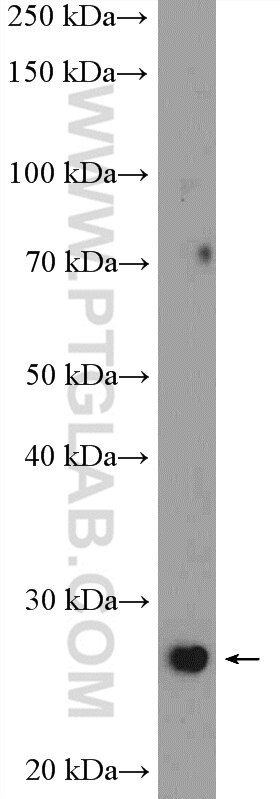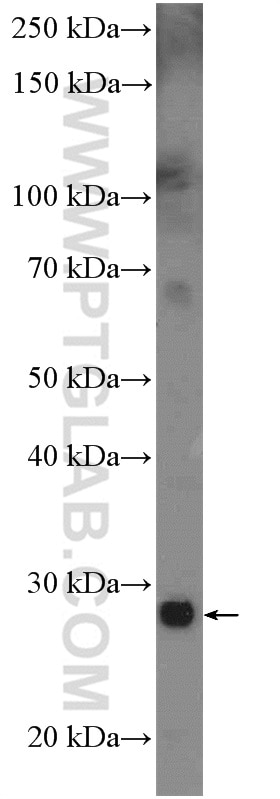ATF5 Polyklonaler Antikörper
ATF5 Polyklonal Antikörper für WB, ELISA
Wirt / Isotyp
Kaninchen / IgG
Getestete Reaktivität
human, Maus, Ratte
Anwendung
WB, ELISA
Konjugation
Unkonjugiert
Kat-Nr. : 15260-1-AP
Synonyme
Geprüfte Anwendungen
| Erfolgreiche Detektion in WB | BxPC-3-Zellen, A549-Zellen |
Empfohlene Verdünnung
| Anwendung | Verdünnung |
|---|---|
| Western Blot (WB) | WB : 1:200-1:1000 |
| It is recommended that this reagent should be titrated in each testing system to obtain optimal results. | |
| Sample-dependent, check data in validation data gallery | |
Veröffentlichte Anwendungen
| WB | See 2 publications below |
Produktinformation
15260-1-AP bindet in WB, ELISA ATF5 und zeigt Reaktivität mit human, Maus, Ratten
| Getestete Reaktivität | human, Maus, Ratte |
| In Publikationen genannte Reaktivität | Maus |
| Wirt / Isotyp | Kaninchen / IgG |
| Klonalität | Polyklonal |
| Typ | Antikörper |
| Immunogen | ATF5 fusion protein Ag7214 |
| Vollständiger Name | activating transcription factor 5 |
| Berechnetes Molekulargewicht | 31 kDa |
| Beobachtetes Molekulargewicht | 27-30 kDa |
| GenBank-Zugangsnummer | BC005174 |
| Gene symbol | ATF5 |
| Gene ID (NCBI) | 22809 |
| Konjugation | Unkonjugiert |
| Form | Liquid |
| Reinigungsmethode | Antigen-Affinitätsreinigung |
| Lagerungspuffer | PBS with 0.02% sodium azide and 50% glycerol |
| Lagerungsbedingungen | Bei -20°C lagern. Nach dem Versand ein Jahr lang stabil Aliquotieren ist bei -20oC Lagerung nicht notwendig. 20ul Größen enthalten 0,1% BSA. |
Hintergrundinformationen
ATF5, also named as Activating transcription factor 5, is a 282 amino acid protein, which belongs to the bZIP family. ATF5 is Widely expressed with higher expression levels in liver. ATF5 is actively transported to the centrosome and accumulated in the pericentriolar material (PCM) during G1 to M phase via a microtubule-dependent mechanism. During late telophase and cytokinesis, it translocates from the centrosome to the midbody (PMID: 26213385) . ATF5 as a transcription factor that either stimulates or represses gene transcription through binding of different DNA regulatory elements such as cAMP response element (CRE) (consensus: 5'-GTGACGT[AC][AG]-3'), ATF5-specific response element (ARE) (consensus: 5'-C[CT]TCT[CT]CCTT[AT]-3') but also the amino acid response element (AARE), present in many viral and cellular promoters. Critically ATF5 is involved, often in a cell type-dependent manner, in cell survival, proliferation, and differentiation (PubMed:10373550, PubMed:15358120, PubMed:21212266, PubMed:20654631).
Publikationen
| Species | Application | Title |
|---|---|---|
J Ethnopharmacol Xinyang tablet alleviated cardiac dysfunction in a cardiac pressure overload model by regulating the receptor-interacting serum/three-protein kinase 3/FUN14 domain containing 1-mediated mitochondrial unfolded protein response and mitophagy |



